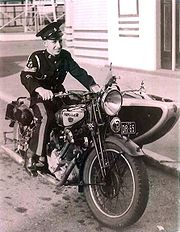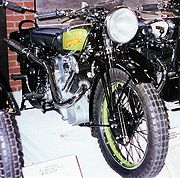
Panther Model 100
Encyclopedia
The Panther Model 100 was a British motorcycle
. It had a 598 cc, 6.5:1 compression ratio, 87 by 100 mm (3.4 by 3.9 ), OHV sloper engine in a frame where the engine replaces the front down-tube. Panthers were manufactured in Cleckheaton
, Yorkshire
from 1900 to 1967. Launched in 1932, the Model 100 continued through to 1963. While the engine and overall layout stayed essentially the same, the specifications steadily evolved over these thirty or so years.
 A 598cc engine was used in the Model 85 Redwing (previously Model 80) from 1929 to 1930 and the Model 60 (previously Model 3) from 1928 to 1935. The Model 100 engine was largely a development from the Model 60. The earlier engines had compression ratios of either 5.4:1 (Model 60 pre-1930) or 7.0:1 (Model 85 and Model 60 post-1929). The frame derives from the 1928 Panther and the tank from the 1932 Model 50. The history of the development of the Model 100 is as follows.
A 598cc engine was used in the Model 85 Redwing (previously Model 80) from 1929 to 1930 and the Model 60 (previously Model 3) from 1928 to 1935. The Model 100 engine was largely a development from the Model 60. The earlier engines had compression ratios of either 5.4:1 (Model 60 pre-1930) or 7.0:1 (Model 85 and Model 60 post-1929). The frame derives from the 1928 Panther and the tank from the 1932 Model 50. The history of the development of the Model 100 is as follows.
1932 - Model 100 launched. P&M 4-speed gearbox, Webb forks.
1933 - Sturmey-Archer
4-speed, hand-change gearbox introduced. Frame redesigned. Terry de luxe saddle.
1934 - Burman
4-speed foot-change gearbox introduced
 1935 - Deeply finned sump and improved lubrication. This new bottom end remained almost unchanged for the next thirty years. This machine had a 6.5:1 compression ratio, 87 by 100 mm (3.4 by 3.9 ), ohv sloper engine.
1935 - Deeply finned sump and improved lubrication. This new bottom end remained almost unchanged for the next thirty years. This machine had a 6.5:1 compression ratio, 87 by 100 mm (3.4 by 3.9 ), ohv sloper engine.
The 1935 Model 100 was the machine on which Miss Florence Blenkiron and Miss Teresa Wallach undertook the epic journey from London to Cape Town, crossing the Sahara: the first such journey on a motorcycle combination.
1937 - New fully chromed fuel tank with red and black lined cream panels and snarling Panther logo. This was the last year of the "Redwing" Model 100
1938 - Kidney-shaped rocker cover introduced. Redwing designation dropped
1939 - Miller Dynamag replaces BTH
magneto. 3.5 gallon tank introduced
1940 - Production ceased for World War II
1946 - Production resumed after war. Lucas magneto introduced.
1947 - Dowty Oleomatic forks introduced
1950 - Manual advance/retard reintroduced
1952 - Lucas Magdyno introduced
1954 - Swinging arm Model 100 introduced. Four gallon tank. Panther forks.
1955 - Amal 376 introduced
1956 - Amal 389 introduced. Heavy duty, sidecar trail Panther forks.
1957 - Swinging arm Model 100 de luxe introduced. Last year of rigid Model 100. Dualseat as standard.
1963 - Model 100 last manufactured. It was the end of the line for 600 cc four stroke heavyweights. The 650 cc Model 120 continued for another three years
yyMxxxz where:
 From "Modern Motorcycle Maintenance"
From "Modern Motorcycle Maintenance"
Tappet Clearance (cold):
Valve Timing:
Tappet Clearances for Valve Settings:
Ignition Advance:
Valve Guides Protrude from Cylinder Head:
Cylinder Bore in Inches:
Piston Clearances:
Piston Rings:
Main Bearings:
Mainshaft:
Big-end/Connecting-rod:
Big-end Bearing:
Gearbox:
Fine-limit Diameters:
Note:
Left-hand Threads:
Special Tools Available from Makers for Comprehensive Overhaul:
Notes
Motorcycle
A motorcycle is a single-track, two-wheeled motor vehicle. Motorcycles vary considerably depending on the task for which they are designed, such as long distance travel, navigating congested urban traffic, cruising, sport and racing, or off-road conditions.Motorcycles are one of the most...
. It had a 598 cc, 6.5:1 compression ratio, 87 by 100 mm (3.4 by 3.9 ), OHV sloper engine in a frame where the engine replaces the front down-tube. Panthers were manufactured in Cleckheaton
Cleckheaton
Cleckheaton is a town within the Metropolitan Borough of Kirklees, in West Yorkshire, England, situated south of Bradford, east of Brighouse, west of Batley and south-west of Leeds...
, Yorkshire
Yorkshire
Yorkshire is a historic county of northern England and the largest in the United Kingdom. Because of its great size in comparison to other English counties, functions have been increasingly undertaken over time by its subdivisions, which have also been subject to periodic reform...
from 1900 to 1967. Launched in 1932, the Model 100 continued through to 1963. While the engine and overall layout stayed essentially the same, the specifications steadily evolved over these thirty or so years.
Development

1932 - Model 100 launched. P&M 4-speed gearbox, Webb forks.
1933 - Sturmey-Archer
Sturmey-Archer
Sturmey-Archer is a manufacturing company originally from Nottingham, England. It primarily produces bicycle hub gears but has also produced motorcycle hubs....
4-speed, hand-change gearbox introduced. Frame redesigned. Terry de luxe saddle.
1934 - Burman
Burman and Sons Ltd
Burman and Sons Ltd, of Ryland Road, Birmingham, England, manufactured Burman-Douglas steering gear.Their recirculating worm and ball design of steering gear was fitted to pre-war vehicles such as the Ford Eight and the Ford Prefect, the Bedford CA, plus many other vehicles - both pre and post-war....
4-speed foot-change gearbox introduced

The 1935 Model 100 was the machine on which Miss Florence Blenkiron and Miss Teresa Wallach undertook the epic journey from London to Cape Town, crossing the Sahara: the first such journey on a motorcycle combination.
1937 - New fully chromed fuel tank with red and black lined cream panels and snarling Panther logo. This was the last year of the "Redwing" Model 100
1938 - Kidney-shaped rocker cover introduced. Redwing designation dropped
1939 - Miller Dynamag replaces BTH
British Thomson-Houston
British Thomson-Houston was a British engineering and heavy industrial company, based at Rugby, Warwickshire, England. They were known primarily for their electrical systems and steam turbines. They were merged with the similar Metropolitan-Vickers company in 1928, but the two maintained their own...
magneto. 3.5 gallon tank introduced
1940 - Production ceased for World War II
World War II
World War II, or the Second World War , was a global conflict lasting from 1939 to 1945, involving most of the world's nations—including all of the great powers—eventually forming two opposing military alliances: the Allies and the Axis...
1946 - Production resumed after war. Lucas magneto introduced.
1947 - Dowty Oleomatic forks introduced
1950 - Manual advance/retard reintroduced
1952 - Lucas Magdyno introduced
1954 - Swinging arm Model 100 introduced. Four gallon tank. Panther forks.
1955 - Amal 376 introduced
1956 - Amal 389 introduced. Heavy duty, sidecar trail Panther forks.
1957 - Swinging arm Model 100 de luxe introduced. Last year of rigid Model 100. Dualseat as standard.
1963 - Model 100 last manufactured. It was the end of the line for 600 cc four stroke heavyweights. The 650 cc Model 120 continued for another three years
Engine numbers
Engine Numbers are of the following formatyyMxxxz where:
- yy stands for the year of manufacture (add 40 if it is a single digit),
- M is the definitive code for a Model 100. Other letters may follow the M:
- MS (pre 1957) MSN swinging arm, half-width hubs
- MS (post 1957) de-luxe
- xxx stands for the serial number, and
- z stands for the modification code.
Detailed technical specifications

Tappet Clearance (cold):
- Inlet, nil.
- Exhaust, nil.
Valve Timing:
- Inlet opens before T.D.C., 25 degrees.
- Inlet closes after B.D.C., 55 degrees.
- Exhaust opens before B.D.C., 70 degrees.
- Exhaust closes after T.D.C., 30 degrees.
Tappet Clearances for Valve Settings:
- Inlet, nil.
- Exhaust, nil.
Ignition Advance:
- 38 degrees full advance.
Valve Guides Protrude from Cylinder Head:
- Inlet, .71875 in.
- Exhaust, .71875 in.
Cylinder Bore in Inches:
- 3.4253 ins. +0005 in.
- Rebore to plus .010 in. when bore exceeds 3.4303 ins.
Piston Clearances:
- Top land, .021 in. to .0225 in.
- Top skirt, .0036 in. to .0041 in.
- Bottom skirt, .0036 in. to .0041 in.
Piston Rings:
- End gap, .010 in.
- Vertical play, .001 in. on all rings.
Main Bearings:
- Driving side: R. & M. LJ. 1⅛ in. (2).
- Timing side: R. & M. LRJ. 1⅛ in.
Mainshaft:
- End float, .030 in.
Big-end/Connecting-rod:
- Side play, .030 in. to .035 in.
Big-end Bearing:
- Type: Hardened steel, double roller.
- Recondition when noisy.
Gearbox:
- Bearings, types and sizes:
- 52mm by 20mm by 15mm.
- 72mm by 1½ ins. by 17mm. Ball races.
- Bushes, (reamed): .9355 in.+.001 in.; .656 in.+.001 in.; .788 in.+.001 in.
Fine-limit Diameters:
- Connecting-rod: Little end(reamed), .876 in. + .0005 in.
- Camshaft bushes, .. .625 in. + .001 in.
- Tappet guides .. .. .3125 in.+ .0005 in.
- Cam-followers .. .. .375 in. + .0005 in.
Note:
- All rocker-box screws are same length with the exception of the centre screw over the push rod tube. If this is inserted in a wrong position there is a danger of cylinder-head breakage when tightening down.
Left-hand Threads:
- Large dynamo driving sprocket. (pre 1950 models).
Special Tools Available from Makers for Comprehensive Overhaul:
- Dowty fork key.
- Clutch nut key.
- Engine sprocket remover.
- Crankpin and engine shaft nut key.
- Main pinion extractor.
- Ball race fitting tools for frame.
- Tappet stud extractor.
- Exhaust nut spanner.
- Valve removing tool.
- Fork ball fitting tool.
Carburettor Settings
Float Body | Note | Source | |||||||||||||
| Year | Spec | Make | Type | Bore | Block | Main | Pilot | Slide | Cut- away | Jet | Needle | Grv. | |||
| 1935 | Solo | Amal | 220 | ||||||||||||
| 1938-45 | Amal | 89/014 | 220 | 29 | /4 | Std. | T-29-Std | 3 | A,B | ||||||
| 1946-50 | Amal | 289C/1A | 1⅛" | 229/069R | 220 | 29 | /3 | Std. | T-29-Std | 3 | 64/156 | A | |||
| 1951-53 | Amal | 289Q/1C | 1⅛" | 229/069R | 220 | 29 | /3 | Std. | T-29-Std | 3 | 64/156B | A | |||
| 1954 | Amal | 289Y/1C | 1⅛" | 229/069R | 220 | 29 | /4 | Std. | T-29-Std | 3 | 64/156B | A | |||
| 1955-56 | Amal | Monobloc 376/30 | 1 1/16" | 376/057 | 250 | 30 | 376 | /3½ | .106 | 2 | 376/098 | ||||
| 1957-66 | Amal | Monobloc 389/21 | 1⅛" | 389/056 | 280 | 30 | 389 | /3½ | .106 | D | 2 | 376/098 | |||
Notes
- A - For Pre-monobloc carbs a Std. needle jet was .106"
- B - Cutaway /3 option

